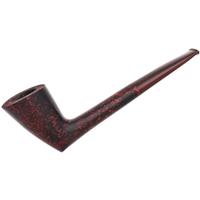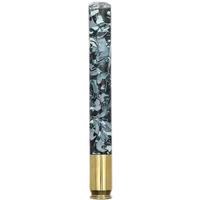Now I want to saw open a briar.No, certainly not saturating with stain. The somewhat sloppy oil reference was to allude to the fact that it's possible to saturate briar with oil, a much thicker substance than a stain, so getting penetration from stain is much easier under varying circumstances. It kind of shoots through at certain spots if the grain is open enough without any special external encouragement.
I use Fiebings Leather dye, premixed.
Bowl Coatings….Why!?
- Thread starter VDL_Piper
- Start date
You are using an out of date browser. It may not display this or other websites correctly.
You should upgrade or use an alternative browser.
You should upgrade or use an alternative browser.
my theory is it's better for their business. It is going to protect the bowl against damage of aggressive smokers and also against unseen imperfections in the chamber. The few of us that complain about it are probably less of an issue then the guy that buys a pipe on a whim and gets burnout because he has zero instruction on how to smoke a pipe. And the thing is if you really hate the coating it is less likely to change your mind on buying a pipe from that brand again, then if you bought a pipe from that brand and experienced burnout. Which I've only experienced in one pipe and it sucked. By the way burnout is like breaking a leg. Very little chance you'll have a question if you did or did not. Or like tongue bite.
My "bowl" coatings have a more organic character , but this is exactly the reason why I do apply them .I'm agnostic when it comes to bowl coatings. Don't care one way or the other and have never once experienced an unpleasant taste from one. Most of what I smoke are ancient Britwood, so the wood has already gone through its break in, probably decades before I was born.
With the new pipes I've bought, some came with a coating and some didn't and I experience no issues either way. I've clearly been lucky that breaking in a pipe has never been a problem. Then again, I notice which makes people tend to bitch about, and don't buy those makes.
One thing though. If you are of a mind to pop the cherry of an ancient pipe, in the neighborhood of a century old, you better make damned sure to coat that chamber first with a thin insulator of charcoal infused silicate or it will likely be the last bowl you'll get from that pipe because you will have split it. Really old briar can become quite delicate. So there's a "why" for the OP.
It is not only about how old the briar is, also about how long a pipe has not been smoked.
So yes, there is a reason for sure.
When I get back to bama, I will. I had a pipe that was leaking tars through the bowl onto my finger each time I smoked it, so I sliced it up. I still have it in my studio. I imagine some briar is more/less porous than others. It probably isn't either or, just various degrees of porosity per pipe.Do you have any pictures you can post of cross sections after the side has been smoothed out, or before and afters? Would be interesting to see.
and the ocean is wet. I am starting to get this image of you just cutting things in half. Which by the way could be a successful youtube channel in my opinion.Now I want to saw open a briar.
Only one that bothered me was a Peterson.
One bowl and the tobacco stuck to the walls in a way I’ve never seen. Created a rough texture crude that was impossible to scrape. Hard as concrete.
Had to wipe that stuff away with alcohol and a ton of Qtips.
One bowl and the tobacco stuck to the walls in a way I’ve never seen. Created a rough texture crude that was impossible to scrape. Hard as concrete.
Had to wipe that stuff away with alcohol and a ton of Qtips.
On my latest two Petes, the bowl coatings came out easily with a wet paper towel. But, something to be careful of, is that the stain seems to also come off easily with water.
I guess I'd be inclined to remove much of the stain when it comes off easily. Cause it's going to continue coming off, be it on hands or buffing cloths.
Don't bother me at all. Smoke few bowls and if tobacco get stuck on the bowl, just ream it out. All my Peterson came with coating except the natural finish ones. Didn't notice much difference between coating and no coating.
My two Petes the one the coating was not an issue at all. Actually seemed to help lay down a good base cake layer. The other one the pipe smoked slightly a little bit less tasty for about ten smokes.
Found it out the hard way, lol. Kept getting stain on my hands, tried hot water for that, but a little alcohol worked the best and stopped the "transfer" on the two pipes (out of many Petes) that had the issue. One was last year's 4AB, so wasn't too happy but it's fine now, the other was my very first pipe, the Rathbone - probably having a super hot bowl with my first run at ever smoking a pipe didn't help, lol, but it was going to happen regardless. When I clear the coating with hot water, it's easy to check now and see if some stain is going to be an issue on the outside - 90% of the time it isn't.I guess I'd be inclined to remove much of the stain when it comes off easily. Cause it's going to continue coming off, be it on hands or buffing cloths.
Brigham coatings are the worst, followed by Peterson. If it really bothers one, you can easily make a bowl coating to spread on the existing. Also one can coat an older estate bowl.
Stanwells sometimes had some stain in there bowls.
Plain yogurt, and powdered charcoal works like a charm, also does a good job repairing damaged bowls.
Stanwells sometimes had some stain in there bowls.
Plain yogurt, and powdered charcoal works like a charm, also does a good job repairing damaged bowls.
YepPlain yogurt, and powdered charcoal works like a charm, also does a good job repairing damaged bowls.
So, if the stain can leak through the briar at certain points does that mean it is an inferior briar or inferior pipe ? Or just that it had porous spots ?
Still waiting on the pictures!When I get back to bama, I will. I had a pipe that was leaking tars through the bowl onto my finger each time I smoked it, so I sliced it up. I still have it in my studio. I imagine some briar is more/less porous than others. It probably isn't either or, just various degrees of porosity per pipe.
The burl on the root of the heath shrub is full of both water and nutrients for the plant.
While it’s living there must be a transfer of water and nutrients through a capillary system.
Everything I’ve ever read about briar mentions the raw burls must be boiled. This is to remove sap or something inside the burl that tastes bad. They’d not boil it unless they had to.
The most valuable in any pipe line is natural, virgin briar. With use it darkens like meerschaum, although since it’s not pure white the darkening is less obvious.
Thd temperature of a burning tobacco ember is close to a thousand degrees. Briar is so excellent an insulator only a quarter inch or so away from the ember you can hold a broken in briar pipe while smoking, and your hand burns at 140 degrees. I wonder if asbestos was as effective as an insulator.
Breaking in briar pipes has been mentioned in everything I’ve ever read about briar. I’m convinced the extreme thousand degree heat, more than the minuscule amount of cake, does something to further cure the pipe and improve insulating properties of the briar.
Whatever is going on during break in, if the pipe maker coated the inside of the chamber he did it to help out a good, paying customer.
Leave it alone and grit your teeth and break it in.
I’ve often wondered when somebody made the first briar pipe and fired it up, why they didn’t put it down and call off the experiment.
While it’s living there must be a transfer of water and nutrients through a capillary system.
Everything I’ve ever read about briar mentions the raw burls must be boiled. This is to remove sap or something inside the burl that tastes bad. They’d not boil it unless they had to.
The most valuable in any pipe line is natural, virgin briar. With use it darkens like meerschaum, although since it’s not pure white the darkening is less obvious.
Thd temperature of a burning tobacco ember is close to a thousand degrees. Briar is so excellent an insulator only a quarter inch or so away from the ember you can hold a broken in briar pipe while smoking, and your hand burns at 140 degrees. I wonder if asbestos was as effective as an insulator.
Breaking in briar pipes has been mentioned in everything I’ve ever read about briar. I’m convinced the extreme thousand degree heat, more than the minuscule amount of cake, does something to further cure the pipe and improve insulating properties of the briar.
Whatever is going on during break in, if the pipe maker coated the inside of the chamber he did it to help out a good, paying customer.
Leave it alone and grit your teeth and break it in.
I’ve often wondered when somebody made the first briar pipe and fired it up, why they didn’t put it down and call off the experiment.
I just now spotted this thread.
Regarding stain penetrating briar to a significant distance, it absolutely can, but rarely does.
It seems to be a "block specific" phenomenon.
Double weird: If the FAR surface is finished, it doesn't happen. It "refuses" to go through.
[cue creepy theramin music]
Regarding stain penetrating briar to a significant distance, it absolutely can, but rarely does.
It seems to be a "block specific" phenomenon.
Double weird: If the FAR surface is finished, it doesn't happen. It "refuses" to go through.
[cue creepy theramin music]
I won't buy a pipe without a proper bowl coating, I hate breaking in new un-coated briar.
Yes, sorry... when I get back home I tend to have 100's of things to get done, and I haven't really even had time to post much here. Lots of family issues... but, a good one is that last night, I did become a Grandpa!... but, since you are anxious, I will get on that when I get back home. I know, I know... I've said that, but I've rarely been back to the Alabama house since Summer began.Still waiting on the pictures!











